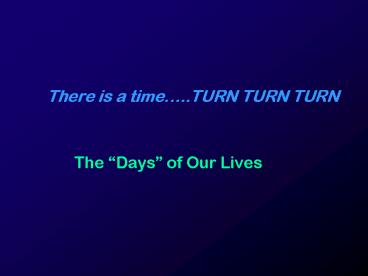There is a time''TURN TURN TURN - PowerPoint PPT Presentation
1 / 14
Title:
There is a time''TURN TURN TURN
Description:
The Sun is directly overhead of the person in a particular ... (4) Autumnal Equinox (Sept. 21) (2) Vernal Equinox (March 21) (1) Winter Solstice (Dec. 21) ... – PowerPoint PPT presentation
Number of Views:29
Avg rating:3.0/5.0
Title: There is a time''TURN TURN TURN
1
There is a time..TURN TURN TURN
- The Days of Our Lives
2
What is a Day?
We start with the Sun, Earth, and person in the
beginning orientation, Noon.
The Sun is directly overhead of the person in a
particular position on the Earth. The Earth is
also spinning about its axis as the day
progresses carrying the person along with it.
Earths Revolution
Earths Rotation
3
Sidereal Day
One Sidereal Day23h 56m 4.09s
The earth has made one complete spin on its axis
and returned the person to the original starting
location with respect to the Earth. However,
notice that it is not Noon the next day.
The Sun is not directly overhead of the person
yet. To reach Noon the next day requires the
Earth to spin an additional amount to reach the
same time orientation.
Earths Revolution
One Sidereal Day
Earths Rotation
4
Solar Day
One Solar Day24h
Because the Earth moves along its orbit around
the Sun, the Earth must rotate nearly 361o to get
from one local noon to the next.
This extra 1o of rotation corresponds to 4
minutes of time.
Earths Revolution
Earths Rotation
5
The CelestialSphere
- Our Earthly Map on the Sky
6
Earthly Coordinates
North Pole
N
W
E
S
Our Astronomer is in the northern hemisphere
(like us) and wants to devise a quick way to find
objects and events on the sky.
South Pole
7
Move the Coordinates Out!
North Circumpole
Celestial Equator
The Night Sky Celestial Sphere
Eq.
Take the coordinates we have an understanding
about and project them onto the night sky.
South Circumpole
8
Add Important Events
N.C.P.
- Now we begin to look for objects, important
events, and observations to add to the celestial
sphere. - Where is the Sun?
- What date is it?
- How are objects moving?
C.E.
S.C.P.
9
What happens during the year?
10
The Celestial Sphere is Complete!
11
Suns Path Winter Solstice
12
Suns Path Vernal Equinox
13
Suns Path Summer Solstice
14
(No Transcript)































